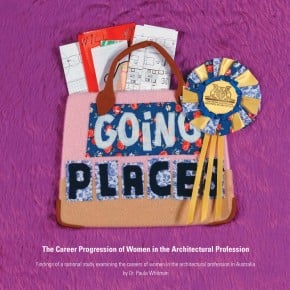Paula Whitman’s 2005 report Going Places: The Career Progression of Women in the Architectural Profession is a fundamental document for research into gender and Australian architecture. The reception of this and the follow-up report, The Career Progression of Men in Architecture, raise important issues for the Women, Leadership and Work research project, which led to Parlour.
Going Places: The Career Progression of Women in the Architectural Profession, by Paula Whitman, provided a comprehensive survey of women in Australian architecture. This provides important context and background for the current research project.
Going Places had 12 major findings:
- That a majority of women would sacrifice career progression for the sake of achieving ‘balance’ in their lives.
- That women are somewhat reluctant to undertake formal career planning, preferring to respond to opportunities if and when they present themselves.
- That offers of career advancement within existing practices are often rejected by women as they question the capacity of the advancement to satisfy their career aspirations.
- That there is a high level of satisfaction among women with their current jobs in terms of balancing work and personal lives and having control over their professional activities.
- That there is a low level of satisfaction among women with their current jobs in terms of remuneration, present rate of career progress and long term career opportunities.
- That the most important career goals for women include building their own practices and taking on new project types and professional challenges.
- That the greatest barriers to career progress experienced by women in the profession include family commitments, lack of time and poor relationships within the industry.
- That by the time women retire, they hope to achieve professional satisfaction and the completion of benchmark projects that make a difference in cultural and environmental terms.
- That women believe that career progression is based on previous performance, technical competency and compatibility with management and staff, as well as having an ability to bring in work.
- Given that women believe “you are only as good as your last project”, the discontinuous pattern of many women’s careers is potentially problematic.
- That women reject the scale of a project, practice size, awards and journal coverage as measures of their personal success, but believe that the profession generally values these factors as indicators of career progression.
- That personal satisfaction and client satisfaction are the most meaningful measures of career progression for women.
These resulted in ten recommendations, all of which remain highly relevant:
- Develop principles for sound equal opportunity workplaces.
- Develop principles for flexible working arrangements specific to small, medium and large scale practices.
- Provide support for women to start their own business and/or re-enter the profession after an absence.
- Provide assistance for women to become and remain members of the Royal Australian Institute of Architects (RAIA), acknowledging the non-linear and interrupted career path of many female members.
- Consider revisions to the architectural curriculum that address the issues of gender and career planning.
- Strengthen the teaching of practice and business management principles to students and recent graduates.
- Recognise, reward and promote the broad range of skills that contribute to great architecture.
- Provide mentoring for women in practice.
- Review registration procedures to ensure equal opportunity.
- Monitor changes to the situation of women within the RAIA membership.
Disappointingly, none of these recommendations seem to have been actively pursued. Nonetheless, the report was responded to in a variety of other ways.
One of the more engaging aspects of the report was the anecdotal comment used to elucidate and enliven the statistical findings. When the report came out I was editor of Architecture Australia. I invited 10 women to further reflect on the findings based in their own experiences. As would be expected, the responses were mixed, partly as an effect of the different backgrounds, career paths and age of the invited respondents.
The Australian Institute of Architects responded by commissioning further research, resulting in the report The Career Progression of Men in Architecture. This found that, in many respects, men had similar experiences, ambitions and expectations, and similar levels of satisfaction and dissatisfaction. These findings are important partly because they suggest that both men and women find aspects of architectural workplace culture problematic, and both value balance between work and life. But, as this second report points out, these similarities also make some aspects of Going Places “more rather than less perplexing”.
Perhaps unsurprisingly, the major difference found between men and women surveyed was the impact of family responsibilities on career progression. That is, although men identified family responsibilities as an issue, they did not perceive them to be a major barrier to career progression – and this is despite the fact that a larger proportion of the men surveyed had children. This leads the second report to end with a question, not a set of recommendations:
“Is this different experience of family responsibilities a sufficient explanation for the large gap between the number of women starting and graduating from architecture courses in Australia and the number of registered women architects?”
This is an important question. I suspect the answer is no – the report writers hint at this also, but offer no further answers or suggestions.
Both reports surveyed the expectations and experiences of individuals in the workplace – but it is important also to look at the cultures of workplaces, at how appointments and promotion are made as well as at the aspirations of individuals for their own careers.
In the years since these surveys were conducted and reports written a number of important new ideas have emerged in studies around gender and the workplace. These suggest there are further areas of investigation and new ways to develop more complex accounts of the mechanisms of career progression and development in architecture. These factors, not raised in the surveys, intertwine with family responsibilities to adversely effect women – they might provide partial answers to the question about whether family responsibilities alone are enough to explain the difference in men’s and women’s experiences.
One of the most important new developments is the idea of unconscious bias – and the related fact that people in senior management positions often appoint and promote those with similar leadership styles to themselves. (See for example the report What Stops Women From Reaching the Top: Confronting the hard issues). I suspect that this is a very important factor in the career progression of women in architecture. Investigating this is one way that the current research project will build on these previous two reports and offer further insight and strategies to address these systemic issues.






















